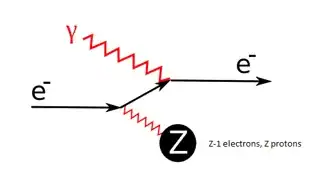When imaging with SEM (Scanning Electron Microscopy) an incident electron ejects an electron from the surface of the sample, which is then detected in order to create an image. In that case I guess that the process is dominantly electromagnetic (right?), so can I write such an equation to describe the process:
$$e^- + X \overset{\gamma*}{\rightarrow} e^- + X^+ + e^-$$
where $\gamma*$ describes a virtual photon, $X$ the target atom and $X^+$ the target atom ionized after the interaction?
My real question is actually about an ion (say $He^+$) hitting a target atom and sputtering a secondary electron. Is it still the electron of the $He^+$ interacting electromagnetically with the target electron, or something else that I cannot think of? And if yes, can I then describe the process as follows:
$$He^++X \overset{\gamma*}{\rightarrow} He^+ + X^+ + e^-$$
? Would there be a chance that the incident ion loses its electron, like:
$$He^+ + X \overset{\gamma*}{\rightarrow} He^{++} + X^+ + 2e^-$$
?
Thanks a lot in advance for your answers.
